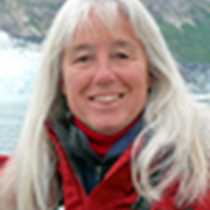National Geographic Sea Lion entered Glacier Bay National Park just after midnight and started the 65-mile journey up-bay toward the masses of ice for which this park is named. We were joined by National Park Service Ranger/Naturalist Kaylin, and Cultural Interpreter Faith, who would relate the dramatic story of ice movement, cultural history, and biological succession that make this park special.
As guests stepped out on deck this lovely morning, a brown (grizzly) bear was spied foraging along the shoreline. We watched in silence for a while and then noticed a black wolf in the grass by a stream. It is a privilege to get a glimpse into the lives of animals in their natural environment in this vast wild place.
We cruised past Lamplugh Glacier and into Johns Hopkins Inlet. One of the most stunning views in all of Southeast Alaska was revealed at Jaw Point. Snowy peaks of the Fairweather Range were bathed in sunlight and decorated with well-placed clouds. The mountains catch moisture from the Pacific Ocean and snow turns to ice, resulting in glaciers that tumble toward the sea. Johns Hopkins Glacier is an advancing tidewater glacier, bucking the current local and world-wide recessional trend. Hundreds of harbor seals rested peacefully on icebergs that had previously calved from the face of the wall of ice, unfazed by the restlessness of the glacier. We were audibly impressed by the “white thunder” as ice broke from the face and crashed into the water with a tremendous splash and rumbling.
We made our way back down-bay, pausing at Gloomy Knob, Tidal and Geikie inlets, South Marble Island, and Boulder Island, marveling at the scenery and being thrilled by mountain goats, two species of puffins, Steller sea lions, and adorable sea otters before arriving at park headquarters during dinner.
To complete the day, there was an opportunity to go ashore in Bartlett Cove for walks and visit the lodge, its display area and gift shop.







